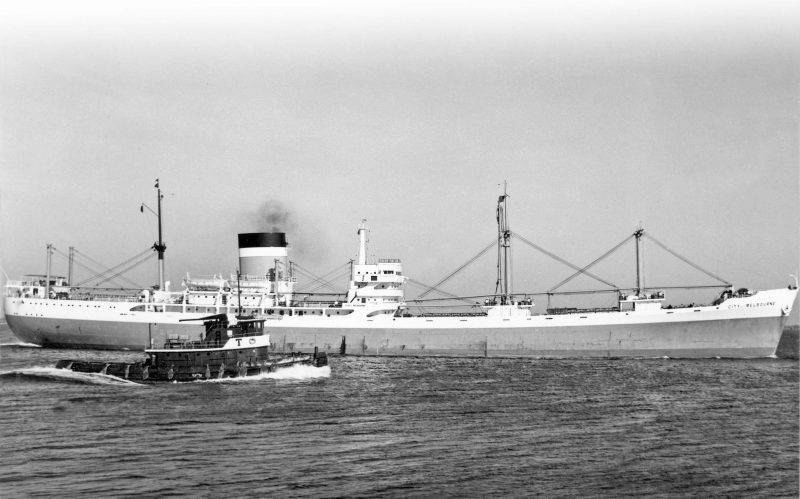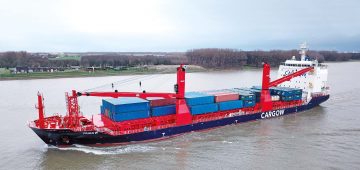
![]() When completed in August 1959 on the Clyde by the Alexander Stephen yard, the stylish closed shelterdecker City of Melbourne was the lead ship of a sextet of cargo-liners with enclosed poop decks and the most powerful diesel engines yet built in Britain. City of Melbourne achieved over 19.9 knots on trials at 116.4 rpm from a Stephen-Sulzer diesel of 14,000 bhp. She was built for the homeward refrigerated meat, grain, wool, and hides trade from Australia with speed as her primary selling point. She was a handsome and elegant ship with five holds and a hatch between the bridge and the funnel trunked down to number four upper and lower ‘tween decks and hold. She had a big cubic capacity of 724,930 cubic feet of which 164,260 cubic feet was for the carriage of refrigerated meat, a trade she would participate in for nine years before the introduction of refrigerated container ships on the Australasian Conference trade routes.
When completed in August 1959 on the Clyde by the Alexander Stephen yard, the stylish closed shelterdecker City of Melbourne was the lead ship of a sextet of cargo-liners with enclosed poop decks and the most powerful diesel engines yet built in Britain. City of Melbourne achieved over 19.9 knots on trials at 116.4 rpm from a Stephen-Sulzer diesel of 14,000 bhp. She was built for the homeward refrigerated meat, grain, wool, and hides trade from Australia with speed as her primary selling point. She was a handsome and elegant ship with five holds and a hatch between the bridge and the funnel trunked down to number four upper and lower ‘tween decks and hold. She had a big cubic capacity of 724,930 cubic feet of which 164,260 cubic feet was for the carriage of refrigerated meat, a trade she would participate in for nine years before the introduction of refrigerated container ships on the Australasian Conference trade routes.
Ellerman Lines Post-World War II
Ellerman Lines Ltd. was established on 22nd January 1902 and became one of the greatest shipping groups in the world with a big fleet of 102 ships on the outbreak of war in September 1939. A dozen of these were passenger and cargo-liners with accommodation for up to 350 passengers on the worldwide empire of trade routes of its City, Hall, Bucknall, Westcott and Laurence, and Papayanni Lines. These were big six hold ships with a gross tonnage of around 10,000 and deadweight of up to 12,500 tons and service speeds of up to sixteen knots e.g. City of Nagpur, City of Paris, City of Simla, City of London and City of Exeter, and the turbine powered twin funnelled City of Benares of 11,081 grt delivered in 1936 by the Barclay, Curle yard on the Clyde. They were used on the route to India and were good, steady vessels carrying large amounts of cargo and passengers.


Apart from six ‘Standard Fast’ cargo-liners built at the end of the war in 1945, all of the many post-World War II Ellerman classes of cargo-liner were five hold ships with a maximum of twelve passengers carried, the only exception being the handsome City of Port Elizabeth class of four ships for the South African trade with accommodation for 107 passengers. This in reality was a ploy by Ellerman to gain priority berthing for the lucrative homeward cargoes from South Africa in their usually congested ports.
The five units of the City of New York class of 1947 were followed by the ten units of the City of Oxford class during 1947/49, the three units of the City of Birkenhead class in 1950/51, the big City of Brisbane and City of Winchester of 13,250 dwt in 1951/52, and the six units of the City of Newcastle class in 1956. A dozen workhorse standard ‘Liberty’ types and a few purchased ‘Empire’ standard types, and other cargo-liners purchased from British owners made up the devastating losses suffered by the fleet at the hands of Nazi Germany. The Ellerman fleet had been rebuilt into a large modern fleet of ninety cargo-liners including the first of an octet of smaller four hold shelterdeckers of 7,770 dwt of the ‘Cathedral Cities’ class, operating worldwide by the time the City of Melbourne took to the water on Tuesday 21st April 1959 at the Linthouse yard of Alexander Stephen & Sons Ltd. as Yard number 651. The hull construction period of eight months involved the erection of 188 vertical frames, longitudinal framing at the double bottom, eight bulkheads, five holds, Shelter Deck, Second Deck, Third Deck, poop decks and fo’c’stle deck and steelwork of the superstructure, Captain’s Bridge and Navigating Bridge.
Sign-up today to read the full article!
Simply click below to sign-up and read the full article, as well as many others, instantly!






Comments
Sorry, comments are closed for this item